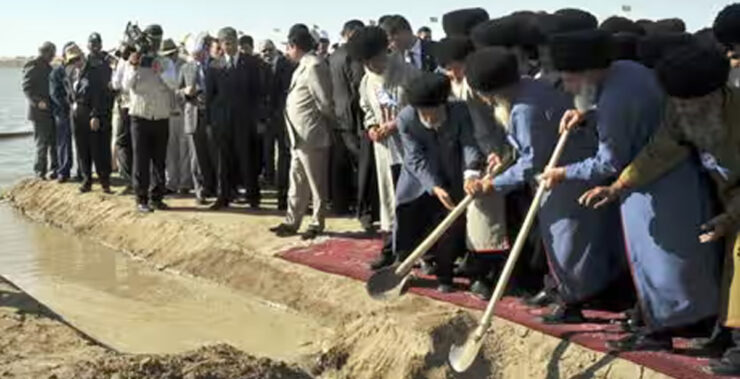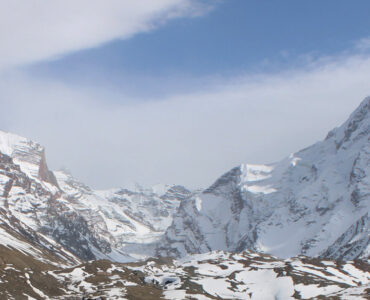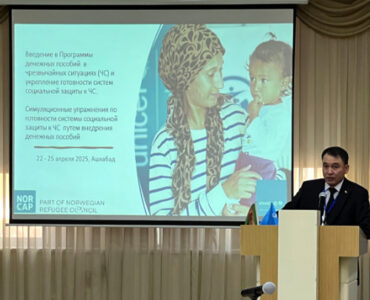Altyn Asyr Lake is a man-made lake in the Karashor depression of the Karakum Desert in Turkmenistan. The project was an evolution of the initial idea to direct collector drainage waters into the Caspian Sea via a Trans-Caspian collector. The realization of the project to create a lake in the Karashor depression was first proposed by Saparmurat Niyazov in the late 1990s and later it was revived by his successor Gurbanguli Berdymukhamedov.
As referenced in the book on the lake titled “The Turkmen Lake Altyn Asyr and Water Resources in Turkmenistan” (2014), the expenses on the project, including digging 2654 km of collectors, should have amounted to $4.5 billion or $6 billion, according to other sources.
The year of 2019 was the last time the Altyn Asyr lake was publicized in the Turkmen state media.
Geographical and physical characteristics
- Location: Altyn Asyr Lake is situated in the Karakum Desert, approximately 264 kilometers from Ashgabat, Turkmenistan.
- Size: The lake is intended to cover an area of about 2,000 square kilometers, with a maximum depth of 70 meters and a total capacity of over 130 cubic kilometers of water. The surface area of the lake was supposed to be roughly half the size of the Sarygamysh Lake.
- Canal System: The lake is intended to be filled using a complex network of canals, totaling around 2,654 kilometers in length. Key components include the 432-kilometer Dashoguz Collector and the 720-kilometer Great Turkmen Collector, which transport agricultural runoff and drainage water from irrigated cotton fields, as shown on the figure below.
Environmental and economic impact
- Ecological Benefits: The creation of Altyn Asyr Lake is part of a broader national initiative to improve the environmental and socio-economic conditions in the Aral Sea basin. It is expected to enhance biodiversity, attract migratory birds, and potentially transform the surrounding desert landscape into a more fertile area, promoting the growth of various flora and fauna.
- Economic Development: The project is anticipated to stimulate local economies through the establishment of fishing industries, aquaculture, and agricultural activities. Plans include the construction of villages that will rely on the lake for their economic sustainability, featuring facilities for fish processing, farming, and recreational activities.
- Infrastructure Development: As part of the lake’s development, infrastructure such as schools, healthcare centers, and community facilities are intended to be built around the lake. Energy projects are planned to ensure adequate resources for these communities.
Donate to support Turkmen analysts, researchers and writers to produce factual, constructive and progressive content in their efforts to educate the public of Turkmenistan.
SUPPORT OUR WORKDespite its potential benefits, the Altyn Asyr Lake project faces several challenges and criticisms. Experts, including the environmental journalist Richard Stone at Science Magazine, voiced their criticism that much of the water is expected to evaporate during transportation and after arriving at the lake. Also, either due to poor construction or simply due to the nature of the land, much of the water flowing through the canals has been seeping into the sands around it. Satellite images on Google Maps show leaked water in the sands around the canal. According to the initial plans in 2009, filling the lake should have taken 15 years, but it is still not filled in 2024. Some experts estimate that filling the lake with its current design of water inflow would take 50 years. The water, sourced from agricultural runoff, would be contaminated with high levels of pesticides and fertilizers.
Occasional news articles continue appearing in state news media praising the progress made on the construction, or in the context of the hybrid solar-wind power plant. The last time it was heavily publicized by state media was in 2019, when the former President Gurbanguly Berdimuhamedov made a visit to inspect the work. Some work has been carried out to send fresh, less contaminated water to the lake to reduce its mineralisation level, by sending rainwater from Ashgabat. The mineralization of the lake was one of the points of concern for international observers, who feared that in order to keep it under control Turkmen authorities might divert some freshwater from the Amu Darya river. The Institute for the War and Peace Reporting feared that it may lead to a regional conflict.






